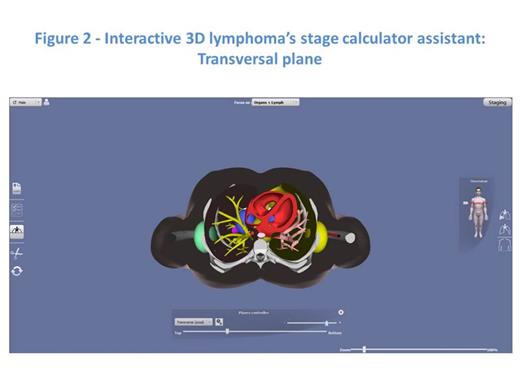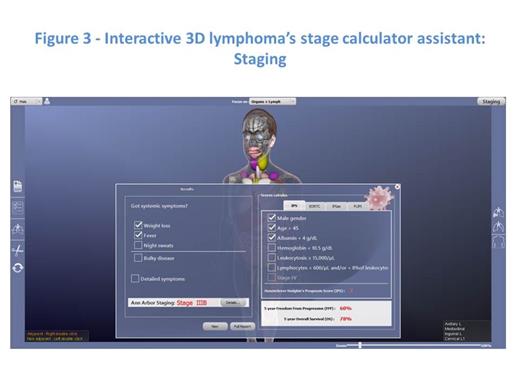Abstract
Introduction:
The lymphomas stages are currently determined by Ann Arbor-Cotswolds classification that have been created during the Committee On Hodgkin Disease Staging Classification, in Ann Arbor (Michigan, USA) in 1971, and modified in Cotswolds (England) in 1988. The classification is used in routine hematology, by doctors and Clinical Research Associates (CRA), in order to estimate the lymphomas' spread, stratify patients and select therapies. In spite of its user-friendliness, every clinician knows that certain scenario depends upon operators.
Despite lots of progress, there is no computerized tool that could help to establish an easy disease staging. A French hematological network, HEMATOLIM, in association with the University Hospital of Limoges, developed an information technology (IT) tool to calculate lymphoma's Ann Arbor stage thanks to 3D interactive model. The aim of this work is to make available online an easy to use calculator for mapping all the lymphoma localizations on a 3D interactive mannequin and then obtain quickly a standardized Ann Arbor's staging.
Methods:
That project has been developed by a mechatronic engineer from the Ecole Nationale Supérieure d'Ingénieur de Limoges, France since April 2013. This software is a 3D interactive model interfacing with Ann Arbor stage's calculator. We used anatomical 3D library files, which represent human body's tissues and organs. This free sharing and use database has been created by a Japanese team (Database Center for Life Science Research Organization of Information and Systems Faculty of Engineering Bldg.12; The University Of Tokyo; 2-11-16 Yayoi, Bunkyo-ku, Tokyo). That base concerns only males and doesn't include lymphatic system. We modified it and added in this database the simplified lymphatic system and created female body's tissues and organs. An expert radiologist approved the resulted projections. To make easier the selection of pathological areas, different tools were created (sectional view tools, magnifying glass, dissection scissors, list selection modality, display of territory's names ). This tool is PC compatible and uses OpenGL (Open Graphics Library) 3D engine. It should be used with updated Windows software and accepts all OpenGL versions (See figures 1, 2 and 3).
With this 1.0 software version, 20 patients with Hodgkin lymphoma (n = 8) and non-Hodgkin lymphomas (n = 12), managed in our institution between May and July 2014, were evaluated. The Ann Arbor stages determined by physicians during multi-disciplinary team sessions (MDT) were compared with the results of software calculated by a junior CRA.
Results:
The rate of agreement between the two methods is 81%. MDT staging and Ann Arbor calculator results were in disagreement in 1 patient (6%). Finally, 3D dynamics model was unable to determinate stages in 2 patients' files because some parts of body are not yet included in the model. Kappa coefficient was estimated to 0.827 ± 0.163 (CI 95%: 0.508 – 1.000), meaning a very good agreement.
Discussion:
We have planned a thorough study to confirm these preliminary results with 80 patients for each stage, in total 320 patients, to obtain a sensitivity or specificity of 95% and 5% of precision. This software represents a consistent help for physicians, hematologists or not. Easy to use, intuitive and fast, it could be an Ann Arbor reference calculator. Improvements are planned for better completeness of the affected tissues. This device could help during MDT to have a standardized and rapid staging. Moreover, that software may be used in educational methods for medical students especially with sectional view tools. It should be very useful in clinical research units to assist in collecting lymphomas data. This software can also help to calculates main scores and prognostic indexes (IPI, FLIPI, IPS ).
Conclusion:
Online and full versions of this 3D lymphoma's stage calculator assistant will be developed by our network to standardize the staging of disease and to optimize treatment decisions. This software developed initially for lymphoma, can be adapted to the TNM classification of cancers. It should be developed with isotopists and radiologists colleagues to create a new tool, in order to deliver the disease stage automatically from CT-scan or PET/CT.
No relevant conflicts of interest to declare.
Author notes
Asterisk with author names denotes non-ASH members.




This feature is available to Subscribers Only
Sign In or Create an Account Close Modal